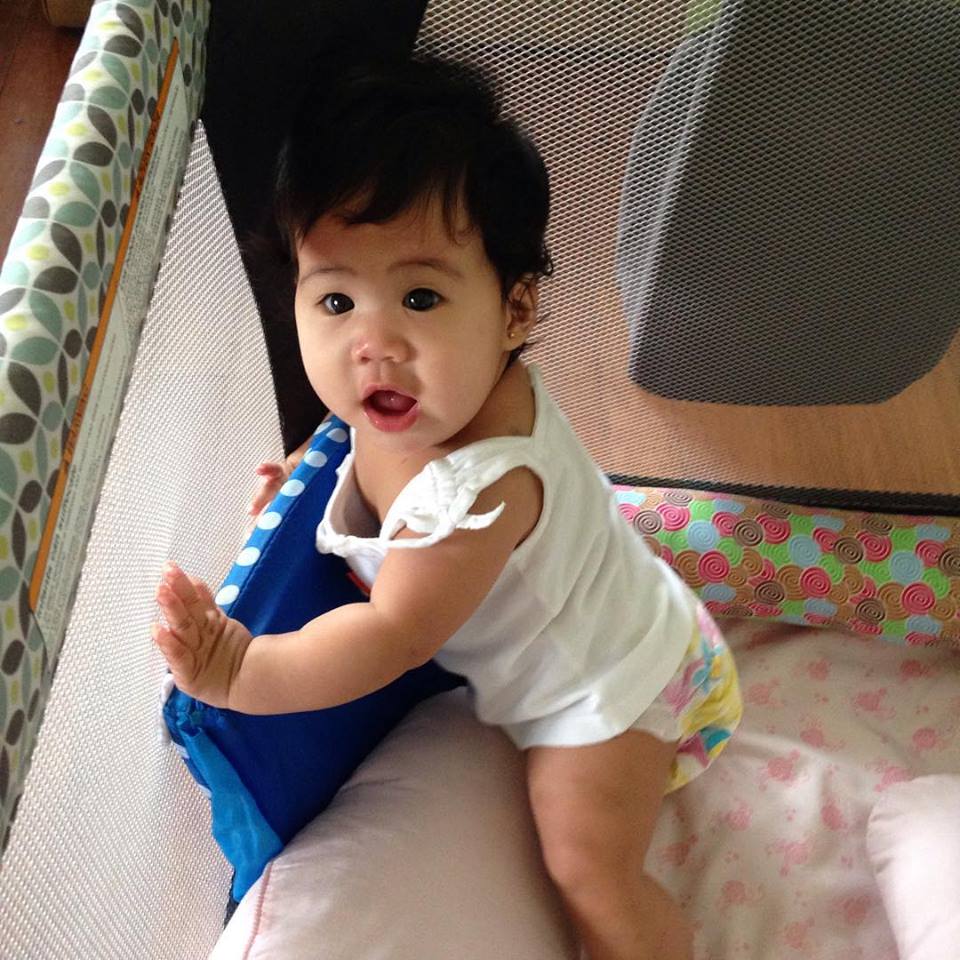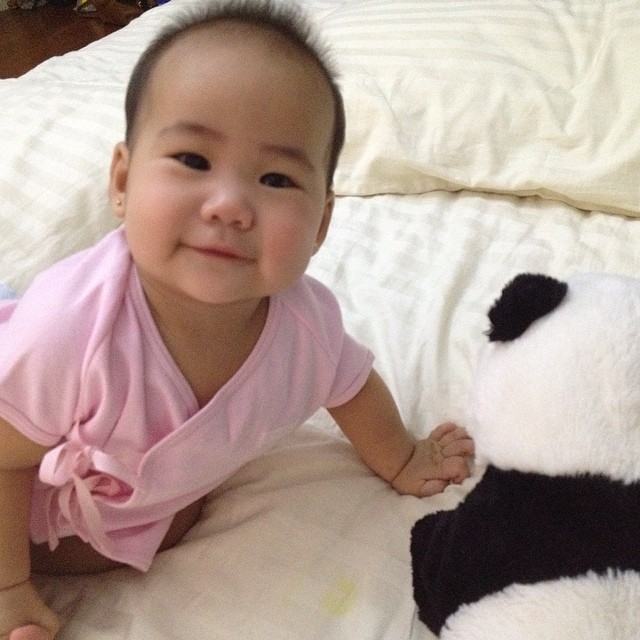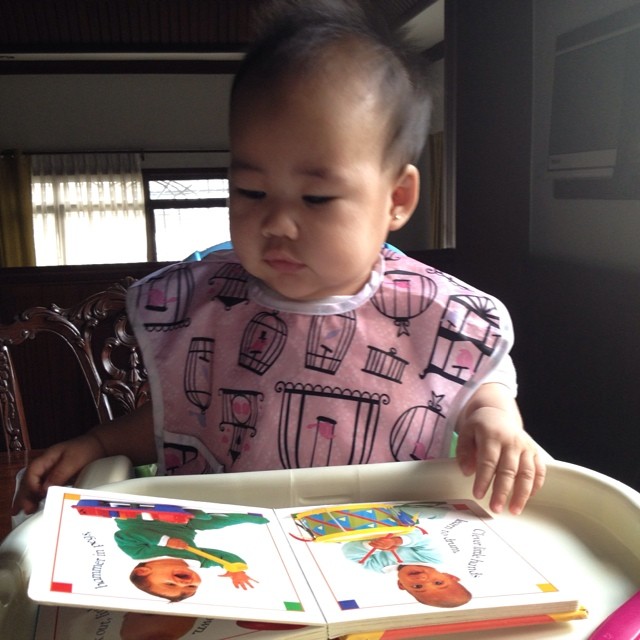Let me continue the series on: Babies and Play, and this time, we’ll talk about babies who are 3-6 months old.
If you’d ask me, personally, I think this is one of the best moments of having an infant: first, because you’d get to have a certain routine with your baby already, which means, a little extra hour of sleep for you and your spouse, next, you feel a certain sense of confidence knowing that you can actually take care of an infant, and best of all, you’d notice several milestones during this stage apart from the usual caregiving routine that you do everyday. Isn’t that amazing? 🙂
According to Zero to Three (zerotothree.org), your baby at 3 months old is becoming more aware about his immediate surrounding and most important of all, the people who care for him and that includes You! I remember my husband, Mike, would be fascinated whenever Ellie and Julia (at 3 months old) would smile back at him or try to “answer” back at him whenever he would talk to them. It’s great to actually see this kind of interaction between you and your child. This is the best time to actually build on that. We’ll talk more about this later on.
At 3-6 months old, these are the many things that your baby can do:
“I am learning to control my body”

Julia’s first attempt to pull herself up
Your child can exhibit the following:
- try to roll to get closer to an object or towards you.
- try to push himself up to see the things that interest him
- roll back and forth on hands and knees
- sit with help and hold head steadily
“Allowing infants to develop their movements naturally and in sequence, without rushing past interim stages, provides them with a solid psychomotor foundation, which will support them for life. Infants have not yet divorced the mental from the physical senses of self, and if adults are careful, perhaps, infants will always remain wholly integrated” (Hammond, 2009, p. 82).
“The desire to use their hands is a great motivator for balancing in more and more precarious poses in the stages between rolling over and sitting. There is no need to think that a baby needs to be sitting up to use both hands and practice hand-eye coordination” (Hammond, 2009, p.97).

“I use my hands and fingers to control”
Babies at this stage are no longer confined to just using their mouths to explore but they are now using their hands and fingers to explore . Ruth Anne explains that the best way to gauge an infant’s readiness for a toy is to actually place the object within his reach or probably, a little bit beyond him. She pointed explained that there is a need to “…allow the baby all of the time he needs to choose when to take notice” (p. 96) because if the baby is interested, he will take notice so there is no need for you to shake it infront of his face.
At this stage, balls of all types become more fascinating for young children. It is amazing to observe that the same toys (played with during the newborn stage) can be used in different ways at a different stage. Ruth Anne shares that, “the little stainless cups may become hooves as they crawl with one in each hand…baskets may be discovered as excellent places to put things…” (p.97).
“I communicate by using my sounds, facial expressions and actions”
Babies at this stage are showing more signs of interaction. They show their response through sounds such as: cooing, blabbing, gurgling, aside from showing the big smiles on their faces.

Julia showed us this face while we were talking to her
“I am ready for books”
Your babies’ ability to touch, mouth, grab books already show their early interest in books. Even if they cannot read yet, exposing them to books (by reading to them and letting them explore and play with these materials) becomes a way to develop early literacy skills and most of all, their love for books.
As parents of 3-6 month old babies, you should keep in mind to:
- give them opportunities to explore and to move while they are on their backs. Ruth Anne Hammond (2009) mentioned that “in this position, they have the maximum opportunity to move their arms and legs freely, to learn that they have control over them and ultimately, to discover their hands” as written in Roche’s article for the Sensory Awareness Foundation Bulletin.

One of Ellie’s favourite play objects. It was a fluffy rabbit.
- Magda Gerber of RIE (Resources for Infant Educators) advocates that a baby should not be put in a position that he cannot get into or out of all by herself. This is why they don’t recommend sitting up babies before they can get there on their own because it will not only cause undue strain on the child’s hips and other body parts but it can also contribute to a child’s feeling of helplessness, which can affect his self-confidence. Hammond pointed out Hanford’s study (2005) that this positioning results in a baby who is immobilised in the pelvic region but also possibly skipping crawling and thus missing the important cross-lateral movement that is important in brain development.

Ellie reaching towards the box and other toys on her own
- Offer toys that are simple but varied in terms of shapes, colours, materials, textures and weights. Toys such as: O-balls, small wooden bowls, short chains of linking rings, napkin, small rag dolls or sock animals, flexible silicone coasters and muffin cups. Keep in mind that safety is a priority- so make sure that they are not small enough to be swallowed, made of safe plastic/materials and next, that they are not heavy enough to hurt when dropped.

- Offer other objects that can motivate movement include: balls (all sizes, weights, textures); baskets; boxes (for pushing, crawling); scarves (for peek-a-boo);
- set-up spaces where you can put: small inflatable pool; big cardboard boxes; low platforms to add an interesting terrain for your child’s play.

Ellie loved moving around boxes such as this one
- Observe your child’s signals and respond. Enjoy back-and-forth conversations with your baby.


- Choose books that are appropriate for your infants. (Board books, cloth books, books with big pictures, books that can be explored during bath time or that can be washed

Ellie’s favourite book at this stage. She loved it whenever we made the sound of each musical instrument.
- Create a regular routine for your child. From waking up to having a bedtime routine, this will help establish a predictable schedule and environment for your baby.

Ellie’s early morning smile during her visit at her lola’s house
Sawyers, J. k. & Rogers, C.S. (2003). Helping Babies Play. Young Children on the Web. pp.1-2
Hammond, R.A. (2009). Respecting babies: A new look at Magda Gerber’s RIE Approach. Washington, DC. ZERO TO THREE.
Zerotothree.org


1 Comment